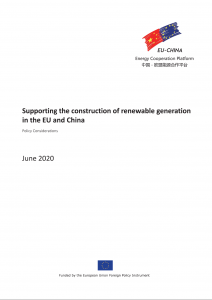
作为世界上最大的发展中国家,拥有近14亿人口,中国消耗的能源比其他任何国家都多。现在决心发展绿色经济,在红线环境限制内推动可持续的经济增长。
然而,如果能源部门没有根本性的转变,经济增长是不可能的。习近平主席提出的“四次革命和一次合作”旨在转变能源消费和能源供给,发展清洁新技术,加强能源安全国际密切合作。
革命的方向也很明确。中国将建设清洁低碳、安全高效的能源体系,高度重视能源安全。习近平主席强调,“低碳能源体系引领人类未来”,减排是实现《巴黎协定》确定的全球目标的关键。
可再生能源是未来能源系统的关键技术之一。中国于 2005 年出台了《可再生能源法》,从那时起,风能和太阳能的推广一直是中国能源战略的基石。中国和欧洲在这些技术的大规模部署以及世界在过去十年中经历的巨大成本降低方面一直处于领先地位。许多风能和太阳能项目已经与化石燃料项目竞争;未来几年,可再生能源将成为最便宜的全球能源解决方案。
然而,仍有许多挑战可能阻碍可再生能源的未来部署和整合。ECECP 三份报告中的两份,“支持
欧盟和中国可再生能源发电建设”和“可变可再生能源在欧盟和中国能源体系中的整合”,强调了未来的挑战,并在各国领导人权衡向低能耗转型的下一步时提供可能的解决方案。 -碳能源系统。许多已经吸取的教训与中国和欧盟相似且相关,但未来的措施必须针对具体的中国和欧盟量身定制。
欧洲语境。投资者需要稳定的政策框架、明确而雄心勃勃的部署和风险缓解目标。同时,电力系统的灵活性和高效的电力市场设计,以及所有技术的公平竞争环境,是可再生能源融入电力系统的重要前提。
这些报告是中欧能源合作的重要里程碑。政策决策者应该学习和借鉴两个领跑者的经验。汲取的经验教训也可能激励其他国家和地区加快可再生能源的开发和整合,以推动全球低碳经济。
Wang Zhongying
总干事
发改委能源研究所
在中国,水电以及最近的光伏和风电的安装和利用逐年增加。尽管可再生能源(主要是光伏和风能)实现了两位数的增长,但除水电外,它们在总消费中的份额仍然可以忽略不计。中国能源系统仍以煤炭为主(占2019年能源使用量的57%)。中国目前是全球最大的风能和太阳能市场,但以生物质燃料为主的非电力可再生能源仍处于起步阶段,发展模式不明确。
中国和欧洲正在共同努力管理向绿色能源的过渡。欧盟委员会最近发布的《欧洲绿色协议》使欧洲在由 27 个不同成员国代表的非常多样化的政治和技术环境中走上了一条前所未有且不可逆转的道路。尽管如此,欧盟能源政策、完善的电网和生产监管以及透明和开放的市场,使欧洲能够最大限度地利用可再生能源并促进其增长。
发展可再生能源是中国和欧洲的重中之重;他们都坚定地支持其经济脱碳,目前他们是最可靠和领先的政治和经济体系,迫切需要工业、社会、运输和整体经济的全面脱碳。
尽管欧洲和中国有着截然不同的政治、经济、地理和历史体系,但过去几十年的相互交流经验可能会导致更广泛的政治和技术选择,从而有利于全球能源转型趋势。欧洲在技术和政策模式方面比中国具有历史时间优势,成员国之间的结果不同,政治和地理复杂性至少与中国相当,甚至更大。因此,中国或许可以借此机会从欧洲的选择、错误和成功以及其政治和技术战略的后果中吸取教训。
最近的历史表明,欧洲不仅在整合可再生能源方面取得了成功,而且在规划支持持续经济增长的能源系统方面也取得了成功。这一成功的证据是,欧盟 27 国的平均一次能源强度——即能源消费与 GDP 的比率——是世界上最低的,是中国的一半。
尽管欧洲和中国之间存在显着差异,正如非常有效地概述的那样
在本报告及其结论和建议中,对两个能源系统的比较提供了明确的结论。欧洲的经验为中国在规划未来几年的能源转型时需要考虑的领域提供了启示。
The first area relates to the need to tackle renewable energy development within a comprehensive, holistic and visionary energy system, taking into account technologies, security, sustainability, and energy intensity reduction across the whole energy value chain and energy sectors (electricity, heating, fuel).
The second lesson from Europe – which has been able to harmonise the complexity of 27 different countries with a variety of policies, a multitude of energy systems and a range of dominant fuels (France with nuclear, Poland with coal, Italy with gas, Scandinavia with
renewable, etc.) – is the value of flexibility and distributed energy production, with approaches aimed at optimising the whole system rather than single technological segments. In this aspect the role of grid regulation and flexibility, cogeneration and prioritising renewables over fossil
fuels are key success factors that China may wish to take into account, carefully adopting UHV solutions that are fully integrated into a distributed power production system.
The third key aspect is market transparency. The focus should be on the end-user who should be able to make a direct contribution to the decarbonisation trend with ‘green’ choices, while bearing higher energy costs for electricity, heating and fuels. Private, commercial and industrial end-users should be given an active role and be offered a choice of energy sources, with appropriate education and awareness of their options. Empowering the consumer will lead to more rapid decarbonisation.
The fourth area of European experience relates to bioenergy and hydrogen. These new technologies, already piloted and adopted in Europe, would mitigate the intermittency of renewable sources, strengthen China’s energy security, contribute to a circular economy, and enhance efforts to reduce emissions through the exploitation of biomasses for producing biogas, biomethane, second generation biofuels, etc. Biogas and hydrogen are the ultimate solutions for decarbonisation of transport, increasing flexibility in the energy system and accelerating the move away from coal while contributing to, and even anticipating, fulfilment of the commitments taken in Paris in 2015.
The fifth, final, and perhaps most pressing point for discussion is the advisability of a genuine opening of China’s market to European companies allowing them to operate in China on a level playing field, as well as through innovative pilot schemes and joint collaborations. This approach could prove the best way to harmonise European and Chinese experience on the ground and on joint projects where European companies can transfer knowledge while developing their business operations in China. This would boost China’s energy transition effort by involving European technologies, processes and regulations and drawing on European companies’ readiness to adapt proven solutions to the Chinese market.
This study provides an excellent basis for understanding the key differences between the power markets in China and Europe and offers a clear depiction of the lessons learned from European and Chinese experiences. It achieves this through a very careful comparative approach that advocates solutions only after considering whether local differences might render them unworkable.
I am absolutely convinced that this report will consolidate and further strengthen cooperation between China and Europe in the context of the EU-China Energy Cooperation Platform. The European Union Chamber of Commerce in China and its energy related members are fully and proactively supportive of the ECECP, in the hope and expectation that it will strengthen mutual cooperation between China and the EU and open up mutually beneficial business opportunities.
Guido D. Giacconi
EUCCC 能源工作组国家主席
In3act商业战略咨询(北京)董事长
本报告由
Monique Voogt,SQ Consult BV 和
国家发改委能源研究所 石景丽、钟才富
英文版 – PDF (34.3 MB), Kindle ( mobi , 9.4 MB), 电子书 ( epub , 3.9 MB)